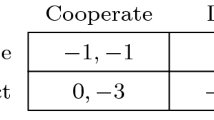Abstract
In most of studies on multiobjective noncooperative games, games are represented in normal form and a solution concept of Pareto equilibrium solutions which is an extension of Nash equilibrium solutions has been focused on. However, for analyzing economic situations and modeling real world applications, we often see cases where the extensive form representation of games is more appropriate than the normal form representation. In this paper, in a multiobjective two-person nonzero-sum game in extensive form, we employ the sequence form of strategy representation to define a nondominated equilibrium solution which is an extension of a Pareto equilibrium solution, and provide a necessary and sufficient condition that a pair of realization plans, which are strategies of players in sequence form, is a nondominated equilibrium solution. Using the necessary and sufficient condition, we formulate a mathematical programming problem yielding nondominated equilibrium solutions. Finally, giving a numerical example, we demonstrate that nondominated equilibrium solutions can be obtained by solving the formulated mathematical programming problem.
Similar content being viewed by others
References
Borm P.E.M., Tijs S.H. and van den Aarssen J.C.M. (1988). Pareto equilibria in multiobjective games. In: Fuchsstein, B., Lengauer, T., and Skaka, H.J. (eds) Methods of Operations Research, pp 303–312. Verlag Anton Hain Meisenheim GmbH, Frankfurt am Main
Borm P., Vermeulen D. and Voorneveld M. (2003). The structure of the set of equilibria for two person multicriteria games. Eur. J. Oper. Res. 148: 480–493
Charnes A., Huang Z.M., Rousseau J.J. and Wei Q.L. (1990). Cone extremal solution of multi-payoff games with cross-constrained strategy set. Optimization 21: 51–69
Corley H.W. (1985). Games with vector payoffs. J. Optim. Theory Appl. 47: 491–498
Koller D., Megiddo N. and von Stengel B. (1996). Efficient computation of equilibria for extensive two-person games. Games Econ. Behav. 14: 247–259
Krieger T. (2003). On Pareto equilibria in vector-valued extensive form games. Math. Meth. Oper. Res. 58: 449–458
Kuhn, H.W., Tucker, A.W.: Nonlinear programming. In: Proceedings of the Second Berkeley Symposium on Mathematical Statistics and Probability. University of California Press, Berkeley, California (1951)
Nishizaki, I., Notsu, T.: Nondominated equilibrium solutions of a multiobjective two-person nonzero-sum game and the corresponding mathematical programming problem. J. Optim. Theory Appl. 135, (2007)
Nishizaki I. and Sakawa M. (1995). Equilibrium solutions for multiobjective bimatrix games incorporating fuzzy goals. J. Optim. Theory Appl. 86: 433–458
Nishizaki I. and Sakawa M. (2000). Equilibrium solutions in multiobjective bimatrix games with fuzzy payoffs and fuzzy goals. Fuzzy Sets Syst. 111: 99–116
Shapley L.S. (1959). Equilibrium points in games with vector payoffs. Nav. Res. Log. Q. 6: 57–61
Tamura K. and Miura S. (1979). Necessary and sufficient conditions for local and global nondominated solutions in decision problems with multi-objectives. J. Optim. Theory Appl. 28: 501–523
Von Stengel B. (1996). Efficient computation of behavior strategies. Games Econ. Behav. 14: 220–246
Voorneveld M., Grahn S. and Dufwenberg M. (2000). Ideal equilibria in noncooperative multicriteria games. Math. Meth. Oper. Res. 52: 65–77
Voorneveld M., Vermeulen D. and Borm P. (1999). Axiomatization of Pareto equilibria in multicriteria games. Games Econ. Behav. 28: 146–154
Wang S.Y. (1993). Existence of a Pareto equilibrium. J. Optim. Theory Appl. 79: 373–384
Wierzbicki, A.P.: Multiple criteria solutions in noncooperative game—theory part III, theoretical foundations. Kyoto Institute of Economic Research Discussion paper, No. 288 (1990)
Yu P.L. (1974). Cone convexity, cone extreme points and nondominated solutions in decision problems with multiobjectives. J. Optim. Theory Appl. 14: 319–377
Zeleny M. (1975). Games with multiple payoffs. Int. J. Game Theory 4: 179–191
Zhao J. (1991). The equilibria of a multiple objective game. Int. J. Game Theory 20: 171–182
Author information
Authors and Affiliations
Corresponding author
Rights and permissions
About this article
Cite this article
Nishizaki, I., Notsu, T. Nondominated equilibrium solutions of a multiobjective two-person nonzero-sum game in extensive form and corresponding mathematical programming problem. J Glob Optim 42, 201–220 (2008). https://doi.org/10.1007/s10898-007-9238-x
Received:
Accepted:
Published:
Issue Date:
DOI: https://doi.org/10.1007/s10898-007-9238-x




